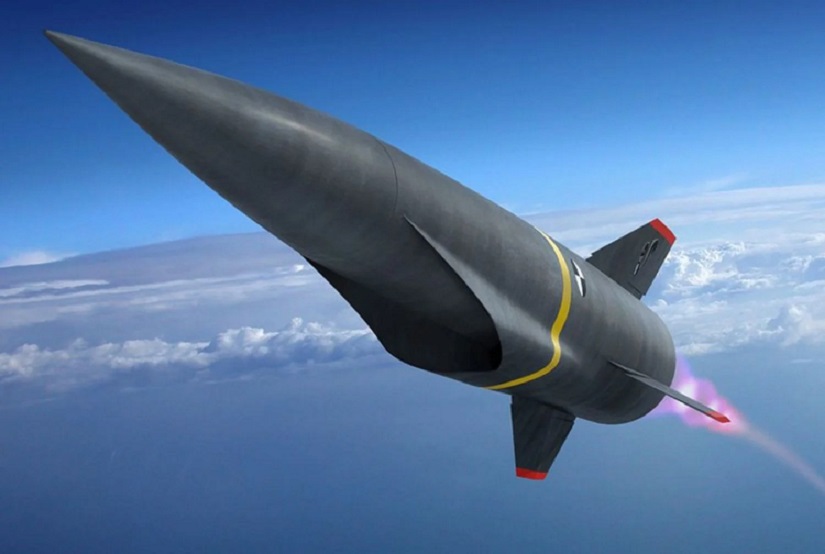Introduction
On September 7th, 2020 India test-fired its first Hypersonic Technology Demonstrator Vehicle (HSTDV) from the APJ Abdul Kalam testing range (in the Wheeler Island) in Odisha. By doing so India became the fourth country in the world after the USA, Russia and China to develop and test hypersonic technology. The Defence Research and Development Organisation (DRDO) which developed the HSTDV called the demonstration successful in its press release as critical technologies such as ‘aerodynamic configuration for supersonic manoeuvers, scramjet propulsion, etc’ were proven.[1] This comes at a time when Prime Minister Narendra Modi has been positing the slogan ‘Atmanirbhar Bharat’ (Self-Reliant India) at the crux of his speech in every possible platform. The indigenously developed technology is not just a first of its kind for India but is a platform to develop much more sophisticated weapon systems that are bound to boost India’s defence capabilities.
Hypersonic Technology
Hypersonic refers to aircraft, missiles, rockets and spacecraft that can travel through the Earth’s atmosphere between the speeds of Mach 5 and Mach 10.[2] Hypersonic platforms will be the centerpiece of 21st-century warfare as they are considered to be far deadlier than the existing weapon systems. Hypersonic weapons – are designed to withstand high temperatures and constitute scramjet propulsion and sophisticated electronics for sensors, communications, guidance and applications in different terrains. [3] Hypersonic weapons increase the accuracy, precision and manoeuvrability of defence operations and are a multi-fold capability amplifier in the modern age of warfare.
Where Other Powers Stand
The USA, in March 2020 tested an unarmed hypersonic missile (Common-Hypersonic Glide Body) successfully. Lt Gen Neil Thurgood who is overseeing Pentagon’s Department of Hypersonics, Directed Energy, Space and Rapid Acquisition is quoted as saying that in the days to come, the pace of the program is bound to increase.[4] The US Army aims to add a mobile-land based capability to its arsenal by 2023. The US Navy and the US Army are trying to build a hypersonic industrial base by leading the design and production development respectively. [5] The US Department of Defence (DoD) has requested 3.2 million USD for the fiscal year 2021 solely to boost the research and development of Hypersonic weapons. As per a study conducted by the Institute for Defence Analyses, USA had 48 critical hypersonic test facilities and mobile assets in 2014.[6] There are multiple other facilities in different US Universities, Norway, Australia and so on. In March 2020, the DoD had even set up a hypersonic war room to assess the status of US Industrial base for Hypersonic Weapons.[7] There has been an enormous focus on perfecting the accuracy to increase lethality. The reason for this aggressive pursuit can be attributed to the fact that Russia and China have entered the hypersonic fray and this has pushed the arms race a step further.
Though the USA tested a prototype hypersonic missile in October 2017, Russia by launching the ‘Avangard’ hypersonic missile in December 2019, became the first country to possess an operable hypersonic weapon. The missile which was launched from the Dombarovskiy missile base in the Urals is claimed to be more than 20 times faster than the speed of sound. Russian President Putin claimed that the development of Avangard was a response to the USA’s missile defence system that neutralises Russia’s nuclear deterrent.[8] Apart from Avangard, Russia is developing the 3M22 Zircon which is a ship-launched hypersonic cruise missile that is capable of travelling at speeds of between Mach 6 and Mach 8.[9] Though it is tough to identify the credibility of ‘Avangard’ being inducted into service, the situation definitely adds more potency to the nuclear arms race. Russia houses its hypersonic wind tunnel testing facility at the Institute of Zhukovsky and Khristianovich Institute of Theoretical and Applied Mechanics, Novosibirsk. Hypersonic testing happens at Dombarovskiy Air Base, Baykonur Cosmodrome and Kura Range. The Russian Navy has been converting old warships into Hypersonic delivery platforms thereby making up for the shortfall in budgetary allocation (The actual budgetary allocation is not known) as well as general weakness.
China for its part has been involved in developing hypersonic technology since 2014. In the National Day Parade on October 01, 2019, China showcased the Dong Feng-17 Hypersonic glide-boost missile. DF-17’s two-fold speciality is that it is capable of cruising at lower altitudes that makes it difficult to track and is highly accurate. [10] Apart from DF-17, China is currently testing of the wave rider hypersonic missile- Xingkong-2. The Xingkong-2 as claimed by China is to counter the adversary’s anti-missile defence system with high speed and manoeuvrability. China is said to have conducted more hypersonic tests than the US and houses an efficient research and development ecosystem dedicated to hypersonic weapons. China also has set up multiple hypersonic wind tunnels and is said to have tested the hypersonic weapons at the Jiuaquan Satellite Launch Centre.[11] As China has shown to the world, its defence programmes focus on high rates of production via efficient programmes and policy backing.
Implications for India
India enters the hypersonic race at a juncture where the USA, Russia and China are already looking into developing improvised hypersonic platforms to stretch their capabilities. It is worthy to mention that India is developing the BrahMos-II of BrahMos Aerospace, an Indo-Russian Joint Venture. The missile will use the scramjet technology that is identical to what Zircon has. However, does India really have the capacity to add more such weapons to its arsenal?
We need to take into account two things, to begin with. Firstly, India has to build a conducive design, development and manufacturing ecosystem. At present, India lacks a dedicated Defence Industrial Base (DIB). Though the words ‘Atmanirbhar Bharat’ stir up a sense of national pride, the practicality of how well hypersonic missile development could blend as a self-reliant endeavour is a question for policymakers to ponder with. Ironically, the BrahMos-II was tested in Russia as India does not house multiple testing facilities as Russia, USA or China does.
Secondly, the economic impact of the same would be far-reaching. As per the 2020-2021 Defence Budget, only 6% has been allocated for the DRDO. Though the share of the Defence budget has increased 9% over the previous budget, the expense meant for modernisation may not bear fruits. The COVID-19 pandemic too has inflicted a major dent to India’s aspirations vis-a-vis the future budgets. The forthcoming budget(s) may not allocate much for defence modernisation either. The major focus will be on covering up for the development rhetoric on other sectors such as education and health.
With that being said, the HSTDV test comes at a time where the tension between India and China has been increasing across the Line of Actual Control (LAC). The test can be viewed as a clear message sent to the Chinese establishment that India is gearing up for the future. Further, in the lines of Amb. Sujan Shinoy’s comment[12], India must work on improving the depth and quality of technology transfer deals with the US and focus on not just buying items off the shelf but on importing sophisticated defence technologies. The Indian policymakers too need to work on putting domestic start-ups and MSMEs to better use, if India was to create an indigenous ecosystem for the Research, Development and manufacturing of futuristic defence technologies. With the help of a holistic policy backing, well-planned technology transfer and the right infrastructure, India can accentuate its efforts towards creating a hypersonic arsenal.
Title Image Courtesy: https://nationalinterest.org/
REFERENCES:
[1] Ministry of Defence, GoI, Defence Research and Development Organisation. (2020, September 07). DRDO successfully flight tests Hypersonic Technology Demonstrator Vehicle [Press release]. Retrieved September 7, 2020, from https://www.pib.gov.in/PressReleasePage.aspx?PRID=1651956
[2] Mach 5 is approximately 4000 mph which is 5 times faster than the speed of sound. The speed of sound per hour is 761.2 mph. Mach 1 simply refers to speed to sound.
[3] J.R., W. (2019, May 01). The emerging world of hypersonic weapons technology. Retrieved September 07, 2020, from https://www.militaryaerospace.com/power/article/14033431/the-emerging-world-of-hypersonic-weapons-technology
[4] Judson, J. (2020, August 05). How the DoD plans to meet its ambitious hypersonic missile test schedule. Retrieved September 07, 2020, from https://www.defensenews.com/digital-show-dailies/smd/2020/08/05/heres-how-the-dod-plans-to-meet-its-ambitious-hypersonic-missile-test-schedule/
[5] Judson, J. (2020, March 20). Pentagon’s major hypersonic glide body flight test deemed success. Retrieved September 07, 2020, from https://www.defensenews.com/smr/army-modernization/2020/03/20/pentagons-major-hypersonic-glide-body-flight-test-deemed-success/
[6] Congresssional Research Service (CRS). (2020, August 27, p09). Hypersonic Weapons: Background and issues for Congress. Retrieved September 08, 2020, from https://fas.org/sgp/crs/weapons/R45811.pdf
[7] Congressional Research Service (CRS). (2020, August 27, p10). Hypersonic Weapons: Background and issues for Congress. Retrieved September 08, 2020, from https://fas.org/sgp/crs/weapons/R45811.pdf
[8] R. (2019, December 27). Avangard: Russia deploys hypersonic nuclear-capable missiles. Retrieved September 07, 2020, from https://www.aljazeera.com/news/2019/12/avangard-russia-commissions-intercontinental-hypersonic-weapon-191227142922561.html
[9] Congresssional Research Service (CRS). (2020, August 27, p12). Hypersonic Weapons: Background and issues for Congress. Retrieved September 08, 2020, from https://fas.org/sgp/crs/weapons/R45811.pdf
[10] Missile Defense Project, “DF-17,” Missile Threat, Center for Strategic and International Studies, February 19, 2020, last modified June 23, 2020, https://missilethreat.csis.org/missile/df-17/
[11] Congresssional Research Service (CRS). (2020, August 27, pp14-pp15). Hypersonic Weapons: Background and issues for Congress. Retrieved September 08, 2020, from https://fas.org/sgp/crs/weapons/R45811.pdf
[12] Shinoy, S. R., Amb. (2019, June 26). Indo-US Defence Partnership: Future Prospects. Retrieved September 08, 2020, from https://idsa.in/idsacomments/indo-us-defence-partnership-srchinoy-260620
Disclaimer: The views and opinions expressed by the author do not necessarily reflect the views of the Government of India and Defence Research and Studies







